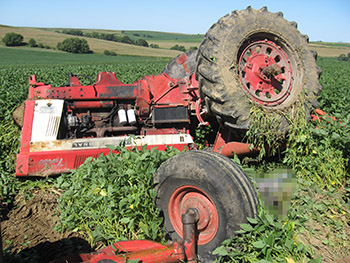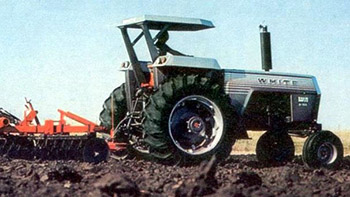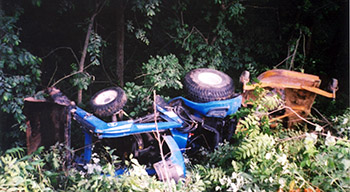Safe operating techniques reduce the risk of overturns.
ROPS reduce the risk of injury or death in the event of an overturn.
DID YOU KNOW…
Tractor overturns are the leading cause of fatal injuries on US farms, resulting in an average of about 130 deaths each year.
1 in 10 operators overturns a tractor in his or her lifetime.
80% of deaths caused by tractor overturns involve experienced operators.
Tractor overturns are costly.
- 1 in 7 farmers involved in tractor overturns is permanently disabled.
- 7 of 10 farms will go out of business within 5 years following a tractor-related fatality.

Accident scene involving a tractor overturn fatality. (Photo courtesy of Iowa FACE Program.)

Tractor with 2-post ROPS. (Photo credit: www.TractorData.com.)

Accident scene involving a tractor overturn fatality where retractable ROPS was secured in folded-down position. (Photo courtesy of Iowa FACE Program.)
Who is at risk?
Because of their high center of gravity, tractors are more susceptible to rolling or turning over than vehicles like passenger cars and trucks, which have a low center of gravity.
While all tractor operators are at risk of overturning a tractor, highest rates of fatalities occur
- in the Midwest, Northeast, and South regions of the US
- in farms involved in crop production
- among farm family members
- among older operators
The most frequent causes of tractor-related deaths are side and rear overturns. The vehicles typically involved in these incidents are older tractors that are not equipped with Roll-Over Protective Structures (ROPS).
What are ROPS?
ROPS are a roll bar or cage frames that are designed specifically for tractors to create a zone of protection around the operator in the event that the tractor overturns. ROPS do not prevent rollovers from occurring; most rollovers result from tractor speed, operator error, or unsafe driving conditions. But in the event of an overturn, ROPS may limit the degree of rollover to 90 degrees.
ROPS are designed to be used in conjunction with seatbelts which keep the operator in place within the protective zone framed by the ROPS. Without a seatbelt, an operator may be thrown from the tractor and crushed by the tractor or the ROPS itself. ROPS are 99% effective in preventing serious injury or death when used with a seatbelt.
ROPS became standard equipment on US-manufactured tractors in 1986, but many tractors manufactured before 1986 are still widely used on farms and unlikely to have been retrofitted with ROPS.
Contact your local implement dealer, extension office, and these websites for assistance in locating ROPS sources by make and model of most tractors built before 1986:
Then have your ROPS and seatbelt installed professionally by an equipment dealer who has experience in installations and identifying potential problems.
If your tractor has a ROPS that is retractable, make sure to keep the ROPS in the upright position. ROPS that are can be folded down must be left upright and locked at all times except when travelling through a low clearance environment.
Do not install or build your own ROPS. ROPS are designed and engineered for specific tractor sizes and weights, and are crush-tested to meet industry standards designed to ensure they perform properly in an overturn. Fabricating or installing ROPS yourself may impart a false sense of security – when in reality there is no assurance that home-made or shop-made ROPS meet standards for all steel, fasteners, and joints which must be tested. Read More
Excuses, Excuses…
“I know how to control my tractor.”
“I will be able to bail out or jump off if I sense I’m in trouble.”
- It takes less than 1 second for a tractor to overturn backwards.
- It is impossible to react quickly enough to jump clear of a rolling tractor. If an operator isn’t struck by the tractor when he or she is thrown off, it is likely they may be struck or crushed by the equipment or load hitched to the tractor.
“It’s expensive / inconvenient to retrofit an older tractor.”
- Some states and programs offer rebates to help offset the cost of ROPS Installation on older tractors. See ROPS Retrofit Program
Safe operating techniques reduce the risk of overturns.
Be aware of terrain characteristics that may increase the risk of a rollover, including ditches, holes, slopes, and unstable ground near roadways or embankments.
Do not operate tractors without ROPS in the following scenarios that increase risk for overturns:
- Working on a slope
- Working where there are unexpected changes in terrain like mounds, dips, or erosion gullies
- Working near or along embankments and ditches
- Handling large loads on an elevated front-end loader
|
Reduce the risk of a rear overturn
|
Reduce the risk of a side rollover
|
|
For more information
Find ROPS
Rollover Protective Structure ROPS Retrofit Program.
Video Links
- National Farm Medicine Center’s ROPS Rebate.
- New York Center for Agricultural Medicine and Health (NYCAMH) ROPS Retrofit Program Videos.
- National Ag Safety Database (NASD). Interviews with overturn survivors and family members of overturn fatality victims, video of overturn situations.
- WorkSafe BC. Tractor Accidents: Three crushed in tractor rollovers.
Resources and References
National Ag Safety Database: topics on tractor overturns, ROPS and seatbelts.
The University of Kentucky College of Public Health. The Kentucky ROPS Guide.
National Agricultural Tractor Safety Initiative.
NASD Rollover Protection for Farm Tractor Operators.
ISU Extension Safe Farm: Use tractors with ROPS to save lives. PM 1265d revised 2013.
The Ohio State University. Ohio State University Extension publication AEX 192.1.56: Rollovers and Rollover Protective Structures (ROPS). 2006.
NIOSH Science Blog: Cost-Effective Rollover Protective Structure (CROPS)
NIOSH Science Blog: Preventing Death and Injury in Tractor Overturns with Roll-over Protective Structures (ROPS).
Cole H. 1997. Pause for thought: should you install a ROPS yourself? Lessons learned.
Fatality case investigations conducted by the NIOSH FACE Program.
(Use the search box under Search FACE Reports to enter keywords such as tractor, overturn, ROPS, rollover, etc.)
Loringer K, Myers J. 2008. Tracking the prevalence of rollover protective structures on U.S. farm tractors: 1993, 2001, and 2004. J Safety Research, 39(5):509-17.
Myers J, Hendricks K. 2010. Agricultural tractor overturn deaths: Assessment of trends and risk factors. Am J Ind Med, 53(7):662-72.
Voaklander D, Day L, Dosman J, Hagel L, Pickett W. 2012. Older farmers and machinery exposure-cause for concern? Am J Ind Med 55(11):1044-50.
